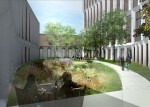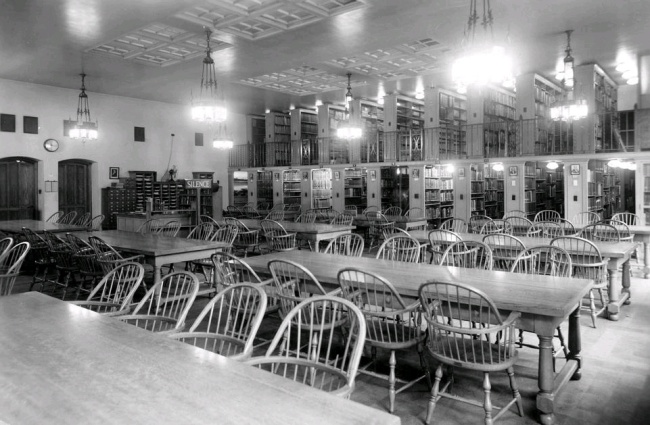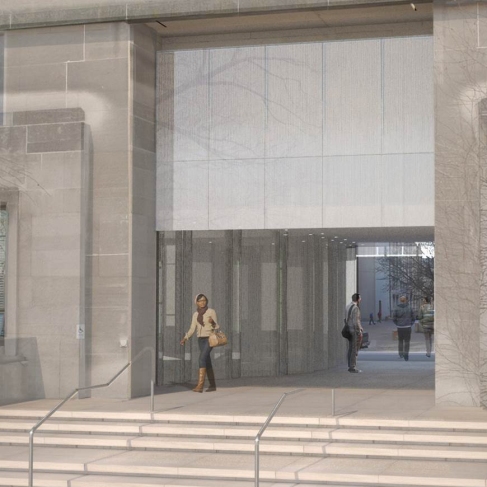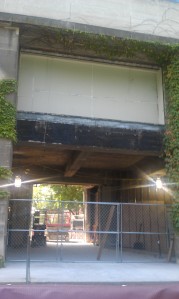Jack Mitchell/The Campus Review
Monthly Archives: July 2013
Complete coverage of new North Campus residence hall
The images:
They are all SGA images, some pulled from the SGA site and others from UChicago’s feature. The two fuzzy pics are screenshots I took during the live webcast of the presentation.
- Model
- Model
- Model 3
- Campus North
- Landscape Plan
- NE Corner/Portal Plaza
- S. University Ave
- View of Crown
- View from Smart
- View from bridge
- Courtyard
- Community Commons
- Community Commons
- Dining hall exterior
- Dining hall
- House hub
- Reading Room
The facts: The new North Campus residence hall (Studio Gang Architects (SGA), expected Fall 2016) promises to house about 800 students, which is 550 more students than were accommodated by Pierce Hall which it replaces. (As everyone knows, Pierce was falling apart and after the famous exploding toilet incident received local news coverage, the University was quick to declare that Pierce had reached the end of its useful life and would be replaced.) These students will be housed in singles, doubles, and South-style apartment units. Like South Campus Residence Hall (Goody Clancy & Associates, 2009), the building will be separated into two units with two Residence Masters and four Houses each. Each House will have a 3-story “hub,” which I will discuss in greater detail later. Unlike South, the building is three blocks (more like Max Palevsky Commons, Ricardo Legorreta, 2000), not one big block, although the blocks are connected.
The complex will cost an estimated $148 million. South Campus Residence Hall, which opened in 2009, cost significantly less at $100 million. Like South does for South Campus, the project is supposed to anchor North Campus and is being called “Campus North Residence Hall” (at least it’s called that on Studio Gang’s website), presumably until a big donor is found. The complex will be comprised of three main structures, a 15-story building along 55th Street, an 11-story building making a diagonal from East to West in the middle of the block, and a 5-story building along S. University Avenue. The buildings are connected by a lounge structure and the dining commons, topped by a green roof. (They’re shooting for LEED Gold.) The 15-story building is 165 feet tall and will have impressive views of the lake and the Downtown skyline. The best way to get a feel of the new residence hall is to watch this video.
Associate VP for Facilities and University Architect Steve Wiesenthal said at the unveiling that SGA won the job over 15 other firms. Mortenson Construction is SGA’s construction partner for the project. It appears that the lead designer is the firm’s founder and principal, Jeanne Gang (pronounced like “genie,” not “Jean”). Her best known work is the undulating, 859-feet mixed use residential tower “Aqua” in the Lakeshore East development downtown. As was discussed at the project’s unveiling this afternoon, SGA is working on two projects in Hyde Park for client Antheus Capital aka Silliman Group aka MAC Properties: the renovation of the Shoreland, the former hotel that became a UChicago residence hall and is now being converted into apartments; and “City Hyde Park,” a mixed use residential development on S. Lake Park Avenue and 51st Street (the Whole Foods that everyone is wishing were a Trader Joe’s is a part of this development). This will be the firm’s first dormitory–hopefully the rooms will be big enough! If students only cared about nice architecture, they would all want to live in Snell or BJ instead of Max or South.
Since the complex has to accommodate many more students than Pierce, it takes up a much bigger site. (The original plans for Pierce had been nearly as ambitious and included a twin tower to the West which was obviously never built.) Gone is North Field which is being replaced by a new field to be built on 61st Street between S. Kimbark and S. Woodlawn Avenues. Also gone is the car access to 56th Street via S. Greenwood Avenue! A portion of Greenwood south of 55th Street up until the entrance to the Campus North Parking Garage (Cesar Pelli & Associates, 2001) will remain, but there is no reason to use it except to access that parking garage or the parking for the residence halls which is hidden under a green roof.
The name “Pierce” is likely to disappear, but the VP for Campus Life and Student Services Karen Warren Coleman said that there will be talks with students to figure out how to “honor” Pierce’s house names. Whoever makes the gift to name this complex cannot possibly top the philanthropic flair of Stanley R. Pierce who literally buried part of his gift in the form of antique gold coins. The vague directions he left before he died, discovered in a safe deposit box by his estate’s lawyers, led to a long treasure hunt. Eventually, all of the treasure was found.
The design: It is sort of unfair to review a project based off of renderings, but my first thought was, “it’s no ‘Aqua,’ but it’s way better than South.” My other thought was, “it’s not a glass box!” Gang has made an honest effort to avoid giving the campus another ephemeral glass building that will look old in ten years. In a funny way, the structure incorporates many design elements from early Modernism: the use of concrete as the primary material (by the way, the concrete will blend in nicely with the campus’s Indiana limestone but, alas, is not Indiana limestone–imagine the cost if it were!); the situation of the buildings in a parklike environment; and the inclusion of a plaza called the “Portal Plaza” on the block’s Northeast corner. At the unveiling presentation, Jeanne Gang described this plaza as the “campus’s new front door.” But seriously, when was the last time since the 1970s that an architect used the term “plaza” without referring to a shopping mall?
However, unlike much American midcentury urban architecture which was also “set back” behind “plazas” in order to create safe havens within dangerous cities, Gang’s dorm has the exact opposite purpose. The University is very conscious of its sensitive relationship with the community and the history behind it. Pierce Hall was built amid a gigantic University-sponsored “urban renewal” project that tore up 55th Street and its numerous bars and jazz clubs and replaced many “high-density” Hyde Park apartment buildings with “low-density” row houses plus two towers (the terrific, International style University Park Condominiums by I.M. Pei, 1961) that concentrated high-density living in one area. Some have credited the project with saving Hyde Park from the fate that befell most of the South Side, but the urban renewal project is also remembered and criticized for its class and race implications. (The context was American suburbanization and whites’ “flight” from cities.)
Pierce Hall opened to good reviews–even in 2006 critic Jay Pridmore admiringly noted the architect’s unconventional choice of bay windows and said that the interior layout “remains unfailingly interesting”–but as time went on students and critics alike pointed out that the large brick wall along 55th Street and the way in which the tower is raised above street level were unambiguous signs that the University was demarcating a campus-neighborhood divide (“keeping locals out”). Of course, it is easy for us today to criticize the way Pierce’s design responded to safety concerns because cities are far safer now than they were in the 1960s and 70s. (I suggested in the preceding post that Pierce’s fortresslike elements may have been partly a product of widespread Cold War fears in addition to the fear that America’s cities were becoming lawless slums.) Gang’s design is a clear indication that the University wishes to distance itself from the urban renewal era.
Is the design successful in welcoming South Siders into UChicago’s campus? We shall have to see, but I think so. The “Portal Plaza” looks welcoming and is unabashedly urban. It reminds me of midcentury plazas such as the Daley Center’s or even the plaza for the Hyde Park Shopping Center on 55th Street that have been truly embraced by communities as public gathering spaces, as opposed to the many corporate plazas that turn their back to the street. The promised retail space will provide a genuine possibility for non-affiliated community members to interact with students. Furthermore, the diagonal walkway that starts at 55th and University and plunges into the heart of North Campus, by the Smart Art Museum’s entrance, is a perfect way for visitors to the University or the museum to have their first experience be a walk through a center of student life. In the presentation, Gang said that in addition to “inviting the community in,” her Portal Plaza and diagonal pathway will encourage students and University people to “extend out.” I don’t see why it would not. Even right now UChicago students make frequent use of that part of 55th Street, whether waiting for the bus to the Green or Red Line or heading to Woodlawn Tap for a few beers with friends.
So besides its being the anti-Pierce, what else is there to say about the design? Well, unlike Max it does not pretend that the campus’s brooding Collegiate Gothic style does not exist. It references the Gothic with its window framing. In the presentation, Gang put it this way: her windows have Gothic-style “tracery,” giving her facades “depth” in the same way as, for example, Rosenwald Hall. It also seems to take a cue from Regenstein Library in its effort to mimic the verticality of Gothic windows and the Gothic style’s unique play of light and shadow. Regenstein Library was designed by Walter Netsch, whose Cadet Chapel at Air Force Academy Gang’s buildings also evoke. However, unlike Cadet Chapel or Eero Saarinen’s Law School on 60th Street, the buildings’ lines do not go in one direction but fluctuate and vary. Compare Gang’s flattened, uneven, or rounded edges to Netsch and Saarinen’s sharp angles. Both succeed in creating beautiful shadows.
Of course, this fluid sort of assymetry is classic Jeanne Gang. At its best (“Aqua”) this approach makes for dynamic facades that surprise the viewer with unexpected waves and naturalistic texture. However, by exchanging order for chaos Gang struggles to make a single point with her architecture. And by now, the approach no longer seems radical. All this is not to say that I don’t like it. I really do. It’s just not a masterpiece. (I want to challenge the University to look for an architect who will make a name for himself/herself with an instantly legendary building–along the lines of the Sydney Opera House or something.)
Gang had lots to say in the unveiling presentation about the inside of the building, which is what really counts. She said that the building was designed from the inside out; the “geometry of what’s inside” “informed” the whole physical structure. I very much agree with SGA’s prioritization of student needs in the design process. For all the external ugliness of Max, and the blandness of South, both buildings are extremely popular with students because they function so well as dormitories. They also, arguably, have strengthened UChicago’s wonderful “House System.” Will this one? I believe so, but it all depends on how well the “House hub” system that Gang has devised plays out, especially since the rooms appear to be on the small side. 3-story “hubs” centralize a House’s common rooms and other common space. My guess is that these hubs will be embraced by the students instantly. It helps that they will be incredibly beautiful multistory spaces.
Gang promises that the House hubs and other shared spaces like a top-floor reading room with gorgeous views and a “community commons” will encourage the University’s academic mission by providing “collaboration zones.” Gang and the other panelists–Dean Boyer, Karen Warren Coleman, and Steve Wiesenthal–also touched about how vital the residential system is for friend making, and that these friendships will prove crucial to any student’s career. (I’m so glad the University of Chicago has stopped pretending that embracing “the life of the mind” will get you a job.) The House hubs will hopefully enhance this effort; the retention of the House table tradition in the new dining hall is crucial. Gang said that she “learned from” Harry Weese, the late architect of Pierce. His “high quality common spaces…inspired” the hubs, she said. He also created ways for students to “people watch,” which apparently will happen in the new dorm’s “cascading” lounges, too.
From what I can tell, the student body is already impressed with the “futuristic” design of the new residence hall, the house hubs, and fifteenth floor reading room. It is true, the students who will get to live in this new facility are very lucky! And I really think that this facility will transform undergraduate housing: with South, Max, and “North,” UChicago will be practically unrivaled among its peers in offering its students modern and conveniently located housing options. Recent grads must be quite envious!
It will also be interesting to see if the less tangible promises come true, for instance what Gang called “a more direct connection between student life and city life.” I hope so. Gang’s striking, energetic design is a wonderful hybrid of campus and urban architecture. It will improve student and campus life, and perhaps even do some good for Hyde Park.
Links:
Video from the UChicago unveiling presentation. University feature article. Piece in The Tribune. Sun-Times. SGA’s web page. Fast Company Design article. UChicago’s videos on it: click here, here, and here. DNA Info article. Chicago Mag article. Arch Daily article. Dexigner article. Chicago Business Journal article. Dean Boyer’s book on housing.
Four summer demolitions and one bygone era
- Stanley R. Pierce Hall aka Pierce Tower (Henry Weese & Associates, 1960), obviously. Is skipping work to watch it go down worth it? Probably. It will happen starting at 8 a.m. on Monday, August 19.
- Ingleside Hall (Charles Atwood, 1896), located at 956 E. 58th Street. In the 1920s this funny building, the Quadrangle Club’s precursor, was literally rolled half a mile from its old location further East on 58th Street so that the Oriental Institute could be built. 12 feet were cut out of the building to make it fit into the new lot. Thank goodness for this alteration because it disqualifies the building from landmark status, meaning that preservationists can do nothing to stop its demolition. Most recently it has been home to a U.S. Post Office. It hasn’t been announced when they will demolish (I will update the post when I know.)
- 6005-6011 S. Woodlawn Avenue, a cluster of brick walkups that have housed faculty. I don’t know when they are being demolished. As to the why, my guess is that space is being cleared on 60th Street to make room for future construction. It may be that the days are numbered for the modernist Stewart Mott Building (Schmidt, Garden & Erikson, 1959) next door, which contains offices for Aramark and several Centers and Programs.
- 6042 South Kimbark Avenue, an attractive Georgian from the turn of the century that has been the address for the Bulletin of Atomic Scientists, a UChicago-affiliated publication formed by Manhattan Project physicists after the end of the Second World War in reaction to Hiroshima and Nagasaki. The publication may seem like a Cold War relic but it has plenty left to say in the era of Chernobyl and North Korea. It coined the disturbing phrase “minutes to midnight” with its Doomsday Clock (midnight=nuclear war=doomsday); for the record it’s FIVE minutes to midnight today. EEK! I’m not sure when this house is being demolished or where the Bulletin’s new headquarters are. It is being demolished to make way for a sports field which replace North Field. (North Field is on the site of the residence hall that will replace Pierce.)
Perhaps Pierce Hall was built so fortresslike because the architect, like the founders of the Bulletin of Atomic Scientists, was responding to the fearful climate of the Cold War. (Forgive me for not figuring out how to hide the captions below; click on the first photo to open the slideshow.)
- We miss the classic American cars from the 60s, but not the constant threat of nuclear war. (Source: University of Chicago Photographic Archive)
- This ill-fated Georgian house was the home of the Bulletin of Atomic Scientists which publishes the famous “Doomsday Clock.” (Source: maps.uchicago.edu)
- 1953: The H-bomb, more powerful than any atomic bomb, is tested and developed by the Americans and then the Soviets. The Bulletin set the clock to two minutes to midnight, the closest it’s ever been!
- Nuclear proliferation in Asia along with the Vietnam War caused the Bulletin to move the minute hand from 12 to 7 minutes to midnight in 1968.
- The 1972 SALT treaty set a limit for both sides on the number of nuclear weapons. The Bulletin drew the minute hand back to 12 minutes to midnight.
- In 1974, India tested its first nuke. The Bulletin moved the minute hand further to 9 minutes to midnight!
- In 1984, US-Soviet relations had completely deteriorated and every channel of communication shut down. The Bulletin warned: only 3 minutes to midnight!
- After the Cold War’s end in 1991, Russia and the U.S. signed the START treaty to jointly reduce stocks of nuclear weapons. In relief the Doomsday Clock moved to 17 minutes to midnight.
- 2012 saw North Korea adopting a harsher tone, prompting the Bulletin to move the minute hand further to 5 minutes to midnight where it remains!
- The global fear of nuclear inhalation finds unforgettable artistic expression in Stanley Kubrick’s darkly funny 1964 “Dr. Strangelove or: How I Learned to Stop Worrying and Love the Bomb.”
Filed under Uncategorized
Eckhart Library to shrink to make room for new offices
Update (July 23, 2014): It’s even worse than I thought! I still haven’t ventured into the new library because it would be sad for me, but you can see what the “modern” version looks like here. The design firm was Woodhouse Tinucci Architects.
Eckhart Hall (built 1930, it is the campus’s sole Charles Klauder building, an architect best known for the University of Pittsburgh’s “Cathedral of Learning”) is in my top five of campus buildings. I’ve never figured out why I like it so much. It may be the narrow proportions of the windows. It may be the perfect naturalness of the ivy cover. I even think it’s perfect on the inside, although if I were a Mathematics or Statistics major I would likely feel differently. Like the Oriental Institute, it is one of only a few buildings on campus that is more or less unchanged from when it was built.
Renovations for academic reasons should always be able to go forward unhindered. Respect for architecture is a very silly reason to prevent an academic institution from doing its job (I’m thinking now of the controversy over Northwestern’s plans to demolish its aging Prentice Women’s Hospital, designed by Bertrand Goldberg and completed in 1975). But despite this core tenet of mine, I am getting very sad about a recent announcement that six new Math and Stat faculty offices will be grafted onto the charming second-floor Eckhart Library. The details are unclear, but the “major” renovation and reconfiguration is likely to significantly shrink and change the appearance of this classic space. The books will go, while the study space will stay. (The terrific “In” and “Out” doors will probably stay too–a silver lining.) So, like Harper, it will be another campus “library” without any books. Oh, well. Crescat scientia; vita excolatur and all that.
But I do wonder how necessary this project is for the Math and Stat Departments. Plenty of other departments have faculty offices in buildings that are not their departments’ home bases. Could Eckhart Library’s fate have been avoided with a more creative plan for increasing space, or a more thorough search for space nearby?
Here’s an old photo. It looks exactly the same today as in the photo. But not come Fall Quarter.
When Steve Wiesenthal wins, we all win
Updated 12/6/2015 to reflect name of architect and add images.
The truth is, he didn’t win. He compromised. The final design for the Administration Building portal project, seen above, is simpler than this one, for example. But I think that’s a good thing. To me, asking the University to spend a lot of money blowing a hole through the perfectly good Admin Building lobby for no other reason other than it would be cool was hubris. I think I am right in saying that the portal being built now is not that expensive since the second floor is largely being kept in tact. It’s also a nice clean, understated design. Still, the fact that any version of this project is actually happening is saying a lot.
Jack Mitchell/The Campus Review
(Here’s the construction on July 10.)
Completed photos here. The firm responsible is Krueck+Sexton, who are masters at performing makeovers on somewhat difficult buildings (buildings from an unloved architectural era, for example).
Steve Wiesenthal is University Architect. Wiesenthal’s philosophy is guided by the principle that distances and spaces matter a lot. He’s the one arguing that S. Ellis Avenue is the backbone of the campus and is woefully unintegrated with the main quadrangles network as well as the Crerar Library quad. For this reason, this summer they’re tearing down one of the oldest and oddest buildings on campus, Ingleside Hall (where the Post Office was; here are pics of the North– and South-facing facades), to “open up” 58th Street to the Crerar quad aka “Science Quad.” Additionally, the University is spending substantial money to turn 58th Street into a “pedestrian way” connecting the medical and main campuses, as the press release put it. When finished it will look something like this:
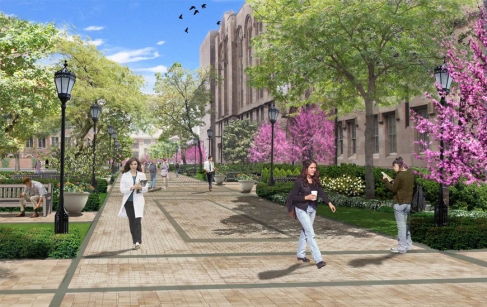 (More pics here.)
(More pics here.)
Pretty cool. Now, some might say that the goal of this plan is sort of an imperialistic let’s-increase-our-acreage type thing. But I tend to think it results from Wiesenthal’s campus planning principles. The portal through the Admin Building proves it, since the portal obviously does nothing to improve the University’s posture. Wiesenthal has convinced Zimmer and everyone that better pedestrian flow and opener spaces, in direct contrast to the early 20th Century cloistered hospitals and quadrangles, are good for students and faculty. Connections encourage “informal encounters” (his words). I think he’s probably right. But I’m more into the fact that it’s an awesome and incredibly imaginative experiment. At what other college campus can one hear talk of “portals,” let alone (to use an example from the completed Midway Plaisance road crossings project by Bauer Latoza and James Carpenter Design Associates, another Wiesenthal brainchild) “light bridges” lit by giant lightsabers? And to think that the Administration is actually funding these things. It’s extravagant, yes, but far less so than Harper Library and Rockefeller Chapel were. Greatness comes at a price. I welcome it and so should we all.
Filed under The Good
Massive parking structure planned for Center for Care and Discovery
The garage will be built by Chicago-based construction company Clayco and is designed by the firm’s architectural arm Forum Studio. At 872,300 sqft it is nearly three quarters the size of Rafael Vinoly’s Center for Care and Discovery.
Additional renderings can be found here and here.
It appears that the structure will fill about two thirds of the rectangle-shaped block that is created by S. Cottage Grove Ave to the West, S. Maryland Ave, 56th Street, and 57th Street to the South. A second story bridge will protrude from the SE corner of the garage to connect it to the center of the hospital. Most interesting of all, in two of the renderings there is a kind of shadow. These are ghostlike outlines of a future tower for doctor’s offices that could one day be built on top of the Western side of the parking garage (which supposedly will be made ultra sturdy for the potential extra weight). Should this tower one day be a reality, it may vex patients in rooms with obstructed skyline views.
I don’t feel like being harsh about the design because it’s a parking garage. It has some merits, although I will say that the “panels of kinetic-art wind veils” (not pictured above), which dance about or something when the wind is blowing–an interesting idea–don’t really do it for me. Partly, this is because they would be so functionless. Parking garages are all about function….Which by the way is not to say that functional structures can’t also be beautiful. Just look at Murphy/Jahn’s wonderful West and South Campus Combined Utility Plants.
I am curious what will happen to the current full block-sized parking garage on Cottage Grove between 58th and 59th Streets. Will it be modified? Demolished? Maybe we will still need all of those parking spots.
Filed under The Meh
Introduction
I made this blog for me. I’d like to have a place to record my thoughts about the constantly changing University of Chicago campus. Because I want to record everything that I learn in one place, the information in the blog will often be exhaustive at the expense of readability.
However, if anyone happens to stumble upon this blog I would appreciate feedback. I want this blog to cover the latest campus architecture news and provide in-depth analyses and reviews that cannot be found anywhere else on the web. I will do my best. The blog format is not at all suited to long-form journalism.
Architecture is a passion for me. It is not my profession or my academic focus. But being a critic is fun. And so is watching a big player make moves. In 2011, when the University signed its “memorandum of understanding” with the City of Chicago, it promised $1.7 billion dollars in capital construction projects over the following five years. We’re right in the middle of this excessive, exciting time.
Filed under Uncategorized










